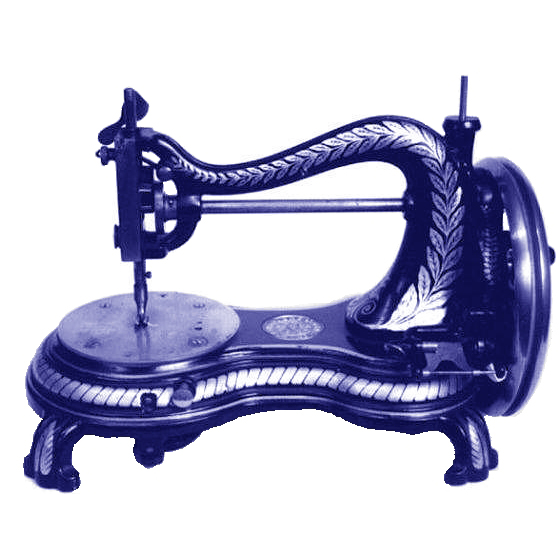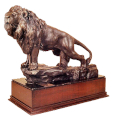REVOLUTIONARY ELNA DEVELOPMENTS
and Developments of Particular Interest and Brief Elna History and Stitches Created by Elna 1994
This information provided to ISMACS courtesy Elna USA
Early contributors to the invention of the sewing machine included Barthelemy Thimonnier, 1829, (chain stitch), Elias Howe , 1845, (double lock stitch), and John Kaiser, 1882, (zig zag stitch). Following is a brief history of Elna sewing machines and stitches whose development has played a major role in the evolution of the modern household sewing machine.
In the late 1930's a refugee from the Spanish Civil War, Dr. Ramon Casas, approached a Swiss manufacturer and supplier of fine timing mechanisms named Tavaro S. A. with designs he had developed for a sewing machine. Elna sewing machines were developed using Casas' ideas and are still manufactured by Tavaro S. A. in Geneva, Switzerland.
| 1940 |
Elna I
The first compact, free arm machine — light in weight, die-cast metal, with a built-in motor and sewing light. Its metal carrying case doubled as an auxiliary sewing table. Signature Elna green finish. |
| 1952 |
Elna Supermatic
Introduced zigzag stitching and a unique "brain" using Elna Discs to produce utility and decorative stitches. First machine to offer true forward-and-reverse stretch stitches — well ahead of its time. Stitches Introduced(ED = Elna-Disc)
|
| 1953 |
Stitches Introduced
|
| 1957 |
Stitches Introduced
Parisian Hemstitch — a machine stitch mimicking traditional handwork. |
| 1959 |
Stitches Introduced
ED 140 – Venetian Hemstitch — used for entredeux trims or inserting lace. |
| 1960 |
Stitch Popularized
ED 107 – Elastic Triple Seam. Originally introduced in 1952 (as Herringbone); rose in popularity with stretch fabrics. |
| 1963 |
Stitches Introduced
ED 149 – Overlock Stitch — the first overlock available on a home sewing machine. |
| 1964 |
Elna Star Series
A group of models offering varied stitches, available in both free-arm and flatbed formats. First domestic machine line to introduce electronic foot control (in 1968). Models included: Elna Supermatic, Star, Zigzag, and EC. Notable FeatureElectric motor with automatic clutch, manufactured in-house by Tavaro S.A. |
| 1965 |
Stitches in Use
ED 125 – Tricot Stitch. Introduced in 1955, but became widely used with the rise of stretch fabrics. |
| 1968 |
Elna Lotus Series
Designed by Raymond Loewy. Compact model with integrated sewing table, case, and accessory box. Received international design awards. Featured a horizontal rotary hook and fold-out flaps. InnovationFirst household machine to include electronic foot control with variable speed and full needle penetration at low RPMs. |
| 1969 |
Elna Lotus-sp
Special variant expanding the Lotus range. Stitches Introduced
|
| 1972 |
Elna SP (Special)
Enhanced the Elna Star line with new features. Stitches IntroducedMultistretch Stitch (Elna TSP) |
| 1974 |
Elna TSP (Top Special)
Top-tier model in the Elna Star series. |
| 1975 |
Elna Lotus-tsp
Introduced dual sewing programs: automatic and superautomatic stitches. |
| 1977 |
Elna Lotus Convertible
Flaps replaced the case — fold out to form a sewing table, remove to reveal the free arm. Stitches Introduced
|
| 1978 |
Elna Air Electronic
Featured air-powered foot control, permanent magnet motor, Synchrocolor stitch selection, and convertible base. |
| 1979 |
Elna Air Electronic Duplex
Flatbed/free-arm variant designed for standard sewing cabinet openings. |
| 1980 |
Elna Stella Air Electronic
Replaced the Lotus line. Updated styling and improved free arm. Retained the air-powered control and Synchrocolor. |
| 1982 |
Elna Carina
Elna's new top-of-line model. Introduced updated motor, raised needle stop, snip cutter, bobbin lift system, clip-on feet, redesigned base and stitch table. Stitches Introduced
|
Other Stitches Pioneered by Elna
- Interlock
- Triple zigzag
- Three-stitch zigzag
- Automatic darning
- Wide variety of other decorative stitches






